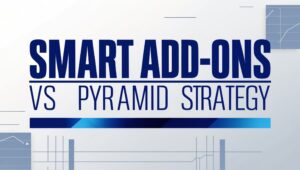How to Effectively and Safely Buy a Gap Up
Buying a gap up can present a great opportunity, but it’s essential to have a well-defined strategy to ensure you manage risk effectively. In this lesson, we’ll break down a proven approach for buying a gap up that can be used with either a 10-minute or 5-minute chart, depending on your preference. This method has been successfully employed by experienced traders like Pat Walker of Mission Winners and is rooted in practical, real-world experience where risk management and precision are key.
Understanding the Gap Up
A gap up occurs when a stock opens significantly higher than its previous closing price, often due to positive news like strong earnings. While this can indicate bullish momentum, it’s crucial to approach it carefully to avoid entering a trade at an unfavorable price or taking on excessive risk.
The Strategy: Steps to Buying a Gap Up
- Identify the Gap Up on the Daily Chart:
- Start by identifying a gap up on the daily chart. Look for a stock that opens significantly higher than its previous close on strong volume. This volume is key as it signals institutional buying interest, which can sustain the upward move.
- Switch to a 10-Minute or 5-Minute Chart:
- Once you’ve identified the gap up on the daily chart, switch to either a 10-minute or 5-minute chart, depending on your preference. Both timeframes work well for timing your entry, with the 5-minute chart allowing for a quicker entry if you’re more comfortable with that pace.
- Evaluate the First Bar (10-Minute or 5-Minute):
- Observe the first bar closely on your chosen timeframe. Ideally, the stock should open strong, run up, and close near the top of its range on heavy volume. This indicates sustained buying interest from the open.
- Set Your Entry Trigger:
- Your entry trigger is when the price takes out the high of the first bar on your selected timeframe. If the stock breaks above this high on continued strong volume, it signals a potential continuation of the move. This is your cue to enter with a small position, as this is an aggressive tactic.
- Control Your Risk:
- To control risk, set a stop loss just below the low of the first bar. Whether you’re using the 10-minute or 5-minute chart, if the stock falls back and takes out this low, it’s a sign that the trade isn’t working, and you should exit to protect your capital.
Switching to a Higher Timeframe for Trade Management
Once you’re in the trade, it’s important not to manage the position on the lower timeframe (10-minute or 5-minute chart) you used for entry. Instead, switch back to the daily chart to monitor and manage the trade. Managing the trade on a higher timeframe, typically the daily chart, allows you to keep the bigger picture in view and reduces the temptation to react to minor price fluctuations that could lead to unnecessary exits.
Real-World Examples
Let’s explore two real-world examples to illustrate this strategy:
- CAVA: Successful Gap Up (Friday, Aug 23, 2024)
- On the daily chart, CAVA shows a significant gap up on strong earnings and volume. Switching to a 10-minute (or 5-minute) chart, the first bar opens strong, runs up, and closes near its high on heavy volume. The next bar breaks above the high of the first bar, triggering the entry. The stock continues to move higher, confirming the strength of the gap up. Once in the trade, switch back to the daily chart to manage it.
- Workday: No Entry (Friday, Aug 23, 2024)
- Similarly, Workday shows a gap up on the daily chart. However, on the 10-minute (or 5-minute) chart, the first bar opens but immediately sells off and never takes out its high. Since the entry trigger (a break above the first bar’s high) never occurs, no trade is made. This highlights the importance of waiting for confirmation to avoid entering a weak setup. Again, if the trade had triggered, you would switch back to the daily chart to manage it.
Managing the Trade
Once you’re in the trade and monitoring it on the daily chart, it’s vital to manage it effectively:
- Partial Profit Taking: If the stock starts to pull back but doesn’t hit your stop, consider selling a third or half of your shares to lock in some profits. This reduces your risk while still allowing you to benefit from further upside.
- Stop Loss: If the stock takes out the low of the first bar on the timeframe you used for entry, sell the remaining position. This disciplined approach to risk management helps you avoid significant losses if the trade goes against you.
Key Takeaways
- Choose Your Timeframe: You can use either a 10-minute or 5-minute chart for your initial entry, depending on your comfort level and trading style.
- Wait for Confirmation: Only enter the trade if the price breaks above the high of the first bar on your selected timeframe, backed by strong volume.
- Control Risk: Set a stop loss below the low of the first bar on the entry timeframe to manage risk effectively.
- Switch to a Higher Timeframe for Management: Once in the trade, manage it on a higher timeframe, typically the daily chart, to maintain perspective and avoid overreacting to minor price movements.
By following this strategy, you can take advantage of gap ups while effectively managing risk and ensuring that you only enter trades with a high probability of success.





